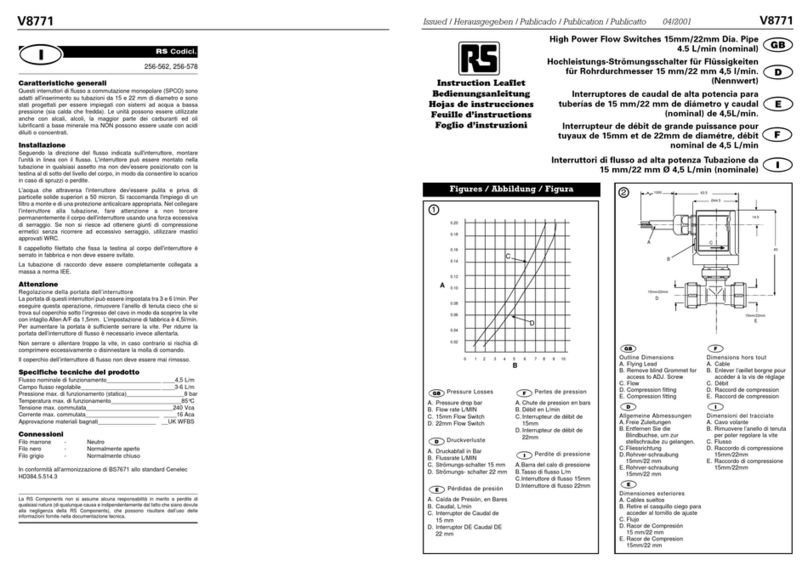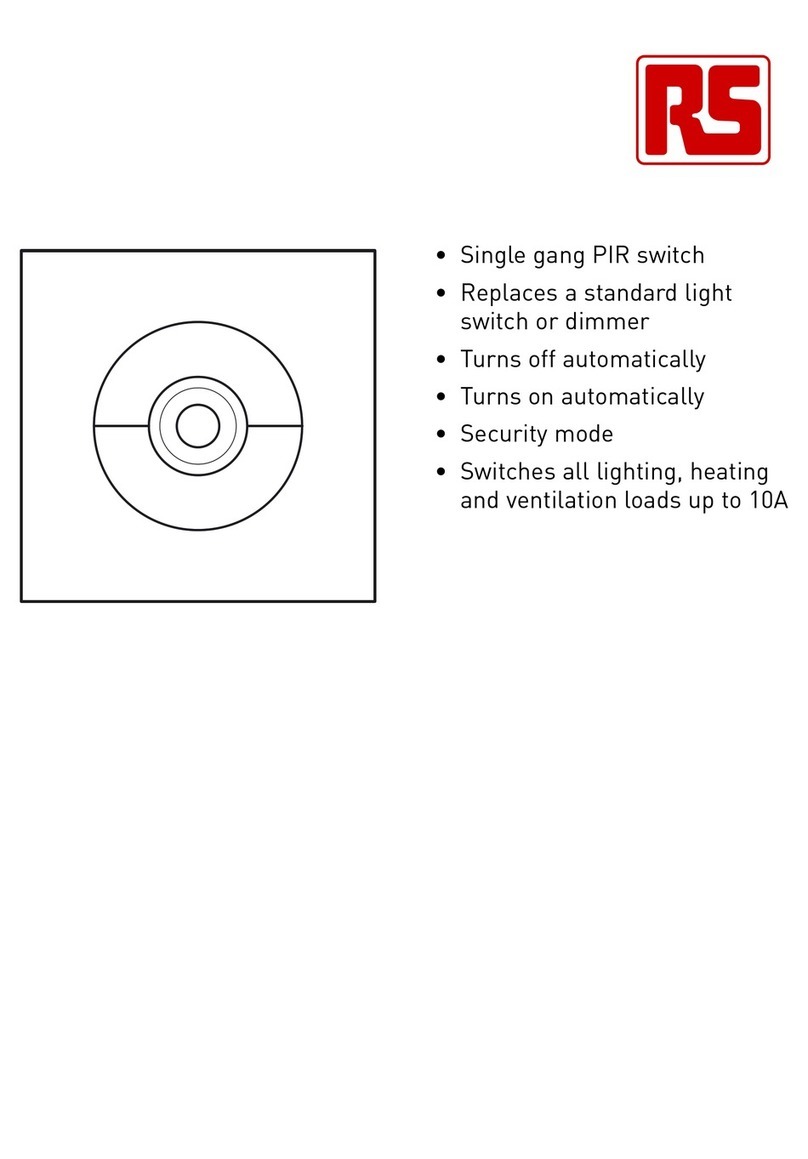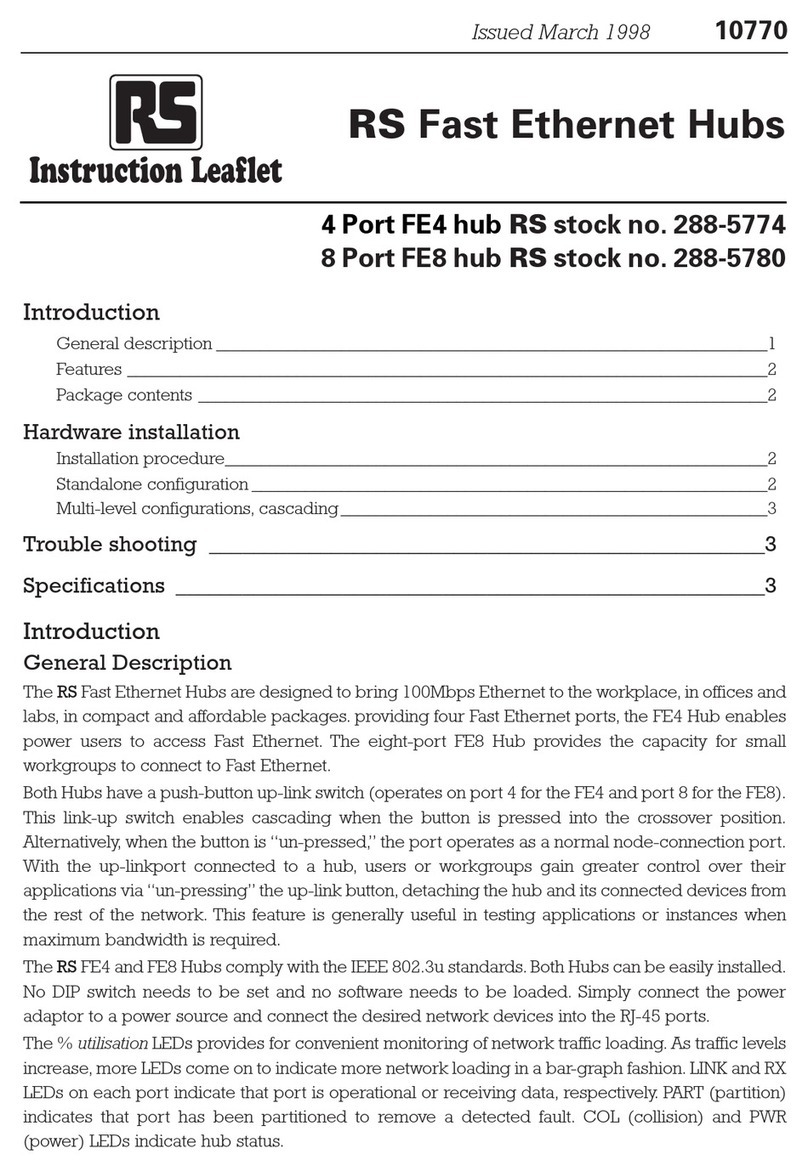2
1.0 Introduction
1.1 Inspecting the Package and Product
Inspect the contents of this package for any signs of damage and
ensure that the items listed below are included.
This package should contain:
1 Magnum DS80 Dual-Speed Hub unit
1 External Power Supply
1 Set of metal clips and screws for secure shelf or wall-mounting
1 Installation and User Guide
1.2 Product Description
DS80 Dual-Speed hubs have eight RJ-45 ports, each 10/100Mbps
auto-sensing. Each port can independently identify (via IEEE 802.3u
auto-sensing) and accept either 100Mbps or 10Mbps Ethernet signals,
adapting to match the best speed of the connected device. There are
two internal traffic domains in DS80 hubs, one for the 100Mbps traffic
and one for the 10Mbps traffic. The 100Mbps users share the 100Mbps
domain’s bandwidth and the 10Mbps users share the 10Mbps domain’s
bandwidth.
The DS80 includes an internal bridge or switch I.C. (Integrated Circuit)
which interconnects the 10Mbps and the 100Mpbs traffic domains. This
enables all users on a DS80 hub, whether 100Mbps or 10Mbps, to talk
to each other. The internal switch of the DS80 filters and selectively
forwards packets between the 10Mbps and the 100Mbps domains,
maintaining peak performance in each domain unaffected by local
traffic in the other domain.
The internal bridge is self-learning, with large address table capacity for
up to 1.8K node addresses.As networked nodes are added or removed
or moved from one speed domain to the other, the DS80’s internal
switch automatically keeps track.
Any DS80 port can connect into either the 100 or the 10Mbps traffic
domain, and can also change from one traffic domain to the other at
any time without affecting the speed of other ports. The automatic per-
port speed-sensing is continuous allowing the connected devices to
change speed at any time without impairing the operation of the other
ports and connected devices.
1.2.1 DS80 Chassis
The DS80 chassis houses one main PC board with a bridge IC on
board, and an external power supply unit. The front side of the chassis
has eight RJ-45 twisted-pair ports and one cascading (Up-link or
Crossover) Port, on the right. LEDs to indicate operating status are on
the left front side. There are power (PWR) and collision (COL)
indicators for the unit. There are Link andActivity (LINK/ACT) indicators
for each of the 10Mbps and 100Mbps domains, set into an aligned
arrangement, for visual indication of the operating status of each port.
The unit has a small quiet cooling fan inside in the centre which sends
warm air out, through the 1/4” plenum space, away from the unit to the
rear.
The DC power plug connector or “jack” is in the right rear of the
chassis.
1.2.2 10/100 Speed Auto-sensing
All eight RJ-45 twisted pair ports support auto-sensing for speed,
independent of the other ports. Speed-sensing is performed by the
DS80’s electronics in accordance with the standards of the IEEE
802.3u auto-negotiation standard. If the connected device or node
indicates that it is capable of 100Mbps speed, then operation on that
port will be at 100Mbps. If the connected device does not positively
indicate that it is capable of 100Mbps speed, then the operation on that
DS80 port will be at 10Mbps. Of course, the hubs’ auto-negotiation
technique is only for 10/100 speed, and does not provide for for any full-
duplex operation.
The per-port 10/100Mbps Link/Activity LEDs on the front panel indicate
the result of auto-sensed speed detection, and the resulting
connectivity to either a 10Mbps or 100Mbps device. The 100Mbps LED
will illuminate (GREEN) when 100Mbps signals are detected; it will be
steady ON if no traffic and blinking ON when the port transmits and
receives data packets. Similarly, the 10 Mbps port will be on when a
10Mbps signal (or no reply to auto-negotiation) is detected, and will
blink if the linked port is transmitting and receiving packets.
1.3 Bridge logic between the 10Mbps and 100Mbps Domains
DS80’s contain a bridge chip (Integrated Circuit) to interconnect the two
traffic domains, filtering and selectively forwarding packets to allow only
necessary packets to cross between the domains. This enables all of
the users and nodes connected into either domain, whether 100Mbps
or 10Mbps, to communicate to each other, and it keeps local traffic on
one domain from consuming any of the bandwidth of the other domain.
The bridge operates in the store-and-forward mode, which filters out
bad packets and maintains optimum performance in both domains.
Packet forwarding delay is only 5µs (plus packet time), much less than
traditional store-and-forward bridge products, enabling DS80’s to
maintain high network performance. The bridge has 1.8K node address
capacity, suitable for use in medium-sized networks. Addresses are
self-learning so that filtering/forwarding of 10Mbps and of 100Mbps
packets is maintained correctly even when users move their
connection, or change speed, or power down.
1.4 Up-link Port for Cascading
The unit has an up-link Port located on the right-front side of the hub. It
enables the port’s cable to cascade to another shared hub or switching
hub port. Like all DS80 ports, this is a dual-speed port which will sense
the speed of the connected device. The up-link operates the same,
whether it is connected to either 100Mbps or 10Mbps devices.
When the up-link port is used to cascade two DS80 hubs, the auto-
sensing feature of the DS80 will cause the connecting link to operate at
100Mbps speed.
1.5 Features and Benefits
Supports 10 or 100Mbps network connections on each of eight
RJ-45 ports
DS80 Dual-Speed 10/100 hubs combine two logical hubs -- one at
10Mbps and one at 100Mbps -- in one physical box supporting two
traffic domains. Each port can operate at either 10 or 100Mbps,
independently of the other ports.
Auto-sensing for speed, 10 or 100Mb on each port
All ports support 10/100 auto-negotiation for speed, operating
separately on each port. Any mix of 10Mbps and 100Mbps users can
be connected to the ports. Speed-sensing is continuous, occurring at
LINK enable. Individual ports can change to 100Mbps or 10Mbps
speed at any time, adapting to any changes in the connected device’s
speed. Speed-sensing complies with IEEE 802.3u, providing
interoperability with other products.
An internal switch connects the 10 and 100Mb domains
The DS80 has an internal switch for filtering/forwarding traffic between
the 10 and 100Mbps domains, allowing all connected devices to
communicate to each other. High performance switching provides full
bandwidth in each domain, unaffected by local traffic on the other
domain.
Installation is “Plug and Play”, operation is transparent to
software
The DS80 operates as a hardware switch, only forwarding those
packets from each domain that are needed on the other domain.
Internal address tables are self-learning, enabling users to change port
connections or 10/100 domains without affecting operations. The
switch in the DS80 will not affect any standard software applications or
SNMP network management platforms.
Small enclosure enables use in offices and labs
The compact packaging of DS80’s allows them to be installed in offices
and labs, or virtually any location within reach of a standard AC wall
outlet. They come in a durable metal enclosure for table-top or wall-
mounting. They have an external AC to 5VDC power supply.
Fan cooled operation for high reliability
A small (6mm) quiet fan inside of the DS80 keeps the 100Mb
electronics cool for longer life without failure, and for operation in very
warm ambient temperatures.
V10830































